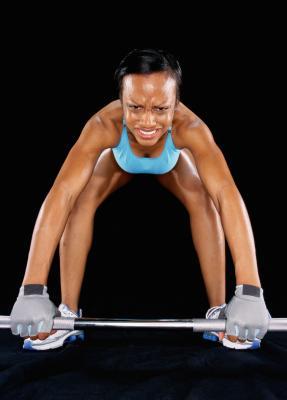Weight lifters use gloves to lessen the pressure on their hands and wrists.
Tendinitis is an inflammation of the connective tissue that joins muscle to bone. This painful condition is usually associated with activities such as tennis, which require repetitive movements, but can also be caused by sudden injury. Weight lifting has both repetitive movements and the risk of injury when proper form is not followed, placing a weight lifter at risk of developing tendinitis. To prevent or reduce the symptoms of tendinitis, some weight lifters use protective gloves, but it’s unclear whether the gloves actually help.
Symptoms of Tendinitis
The swelling associated with tendinitis may cause several difficulties in the affected joint. The nearby joint will be painful to move, and you may even hear grating or cracking sounds when you try to use it. It may also be painful to put weight on the joint, requiring you to limit your activity. In more serious cases, a lump could develop on the tendon that is visible through your skin. It’s also possible for the tendon to rupture from overuse.
Weight Lifting & Tendinitis
Several movements practiced by weight lifters could cause tendinitis, especially in the wrist. This relatively small joint is wrapped in several tendons and is asked to support large amounts of weight in most upper-body exercises, including biceps curls and bench presses. Over time, these muscles tighten as they are worked and pull on the tendons, which are less flexible. The increased tension will cause tiny tears that result in tendinitis. Irritation is also possible in exercises that force your wrists to bend at an extreme angle before supporting weight, such as pushups.
Can Gloves Help ?
Weight-lifting gloves add padding to your palms and fingers to lessen the pressure on your hands and wrists during a workout. Most gloves include wrist wraps that support the wrist and help to keep it properly aligned. This extra help for your wrists could help to prevent tendinitis, but the evidence to support their use is largely anecdotal, and it is still possible to injure your wrists while wearing them. Padded gloves with support straps could go a long way toward helping those who already have tendinitis, though. The padding will protect sensitive nerves from the pressure of the lift, but you should still use caution and speak with your doctor before exercising with tendinitis.
Other Considerations
If you experience these symptoms and suspect that you have tendinitis, see a doctor immediately. Exercising despite the pain could worsen your condition. The best and most effective treatment for tendinitis is still rest and ice to reduce the swelling.
To prevent tendinitis, stretch the muscles you’re going to be working, holding each stretch for at least 20 seconds. Do a few sets of warm-up lifts with lighter weights before jumping into your regular routine. A warm up will increase blood flow and raise the temperature of the involved muscles, which will improve flexibility and help prevent injury.
